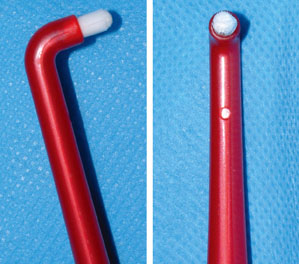J Periodontal Implant Sci.
2011 Jun;41(3):131-134. 10.5051/jpis.2011.41.3.131.
The plaque-removing efficacy of a single-tufted brush on the lingual and buccal surfaces of the molars
- Affiliations
-
- 1Department of Periodontology, Gangnam Severance Hospital, Yonsei University College of Dentistry, Seoul, Korea. ismoon@yuhs.ac
- KMID: 1783603
- DOI: http://doi.org/10.5051/jpis.2011.41.3.131
Abstract
- PURPOSE
To test the plaque-removal efficacy of a single-tufted toothbrush on the posterior molars compared with a flat-trimmed toothbrush.
METHODS
Forty-nine subjects were selected. Professional instruction and written brushing instructions were given. After thorough supra-gingival scaling and polishing, all subjects were asked to abstain from oral hygiene procedures for 24 hours prior to the first experiment. The subjects were randomized to a treatment sequence. The modified Quigley and Hein plaque index was recorded pre- and post-tooth brushing, at 6 surfaces of the posterior molars. After a wash-out period, all the remaining plaque was removed professionally. Twenty-four hours of brushing abstinence was again performed. The plaque index was recorded pre- and post-tooth brushing after the subjects were given the second toothbrush in the cross-over sequence.
RESULTS
The percentage reductions in plaque scores achieved with the single-tufted brushes were significantly higher than those of the flat-trimmed brush at the maxillary buccal interproximal, marginal and mandibular lingual interproximal site. The other locations showed no significant difference.
CONCLUSIONS
The results of the present study implied that the single-tufted brush could be an effective tool for the removal of plaque at some, but not all, sites of the posterior molars.
Keyword
Figure
Reference
-
1. Axelsson P, Nyström B, Lindhe J. The long-term effect of a plaque control program on tooth mortality, caries and periodontal disease in adults. Results after 30 years of maintenance. J Clin Periodontol. 2004. 31:749–757.
Article2. Corbet EF, Davies WI. The role of supragingival plaque in the control of progressive periodontal disease: a review. J Clin Periodontol. 1993. 20:307–313.
Article3. Cumming BR, Löe H. Consistency of plaque distribution in individuals without special home care instruction. J Periodontal Res. 1973. 8:94–100.
Article4. Söder B, Johannsen A, Lagerlöf F. Percent of plaque on individual tooth surfaces and differences in plaque area between adjacent teeth in healthy adults. Int J Dent Hyg. 2003. 1:23–28.
Article5. Jepsen S. Lang NP, Attstrom R, Löe H, editors. The role of manual toothbrushes in effective plaque control: advantages and limitations. Proceedings of the European Workshop on Mechanical plaque control: status of the art and science of dental plaque control: Castle of München-wiler, Berne, Switzerland, May 9-12, 1998. 1998. Chicago: Quintessence Publishing Co;121–137.6. Chava VK. An evaluation of the efficacy of a curved bristle and conventional toothbrush: a comparative clinical study. J Periodontol. 2000. 71:785–789.
Article7. McCracken GI, Heasman L, Stacey F, Kelly PJ, Heasman PA. Testing the efficacy of plaque removal of a prototype brush head for a powered toothbrush. J Clin Periodontol. 2000. 27:542–548.
Article8. Doğan MC, Alaçam A, Aşici N, Odabaş M, Seydaoğlu G. Clinical evaluation of the plaque-removing ability of three different toothbrushes in a mentally disabled group. Acta Odontol Scand. 2004. 62:350–354.
Article9. Rylander H, Lindhe J. Lindhe J, Karring T, Lang NP, editors. Cause-related periodontal therapy. Clinical period-ontology and implant dentistry. 1997. 3rd ed. Copenhagen: Munksgaard;438–460.10. McCracken GI, Steen N, Preshaw PM, Heasman L, Stacey F, Heasman PA. The crossover design to evaluate the efficacy of plaque removal in tooth-brushing studies. J Clin Periodontol. 2005. 32:1157–1162.
Article11. Graveland MP, Rosema NA, Timmerman MF, Van der Weijden GA. The plaque-removing efficacy of a finger brush (I-Brush). J Clin Periodontol. 2004. 31:1084–1087.
Article12. Quigley GA, Hein JW. Comparative cleansing efficiency of manual and power brushing. J Am Dent Assoc. 1962. 65:26–29.
Article13. Turesky S, Gilmore ND, Glickman I. Reduced plaque formation by the chloromethyl analogue of victamine C. J Periodontol. 1970. 41:41–43.
Article14. Claydon N, Addy M. Comparative single-use plaque removal by toothbrushes of different designs. J Clin Periodontol. 1996. 23:1112–1116.
Article15. Claydon N, Addy M, Scratcher C, Ley F, Newcombe R. Comparative professional plaque removal study using 8 branded toothbrushes. J Clin Periodontol. 2002. 29:310–316.
Article16. Furuichi Y, Lindhe J, Ramberg P, Volpe AR. Patterns of de novo plaque formation in the human dentition. J Clin Periodontol. 1992. 19:423–433.
Article17. van der Weijden GA, Timmerman MF, Reijerse E, Danser MM, Mantel MS, Nijboer A, et al. The long-term effect of an oscillating/rotating electric toothbrush on gingivitis: an 8-month clinical study. J Clin Periodontol. 1994. 21:139–145.
Article
- Full Text Links
- Actions
-
Cited
- CITED
-
- Close
- Share
- Similar articles
-
- Evaluation of Tooth Reduction for Prefabricated Zirconia Crowns in Primary First Molars Using 3D Scanner
- Study on the plaque removal efficacy of single-tufted toothbrush: scoping review
- The characteristics of Korean multi-rooted teeth root trunk extracted by periodontal disease
- The effect of a calibrated interproximal brush on proximal plaque removal and periodontal health: a randomized controlled trial
- The Location of Molar Furcation in Korean



